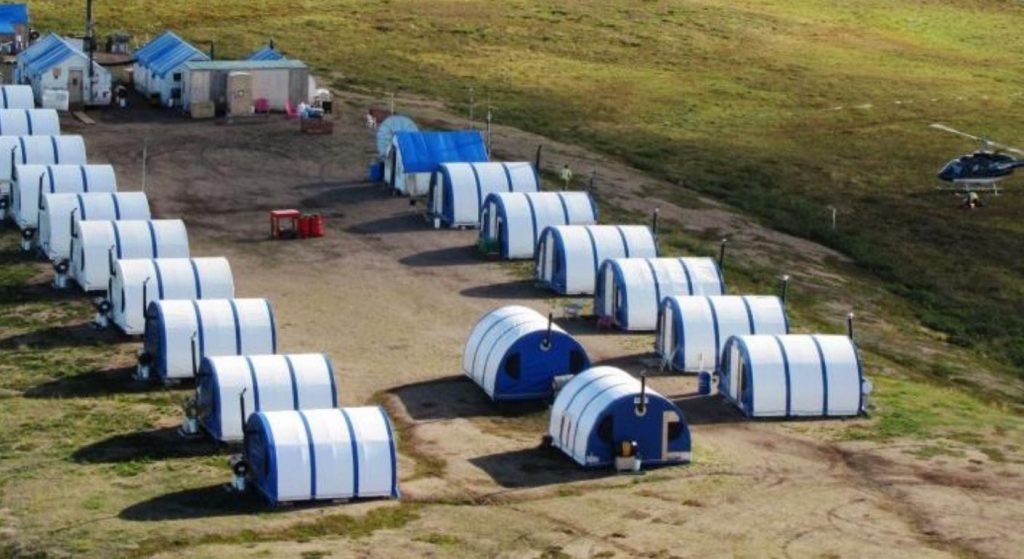Valore Metals drills near-surface uranium at Angilak, Nunavut

Valore Metals Corp. [VO-TSXV; KVLQF-OTC] reported a preliminary update on the reverse circulation (RC) drilling at its 100%-owned, 59,483-hectare Angilak property uranium project located in Nunavut, northern Canada. All seven RC holes drilled at the Dipole target have intersected multiple, shallow zones of radioactivity.
Colin Smith, VP of Exploration, said, “Dipole was first drilled in 2015, where 9 of 9 Valore diamond drill holes intersected multiple zones of near surface uranium mineralization in rocks analogous to those found in the Lac 50 Trend deposits. 2022 RC drilling at Dipole confirms that U3O8 mineralization remains open at depth and along strike in both directions coincident to a 3.4-km-long, coincident, VLF-EM conductor and uranium-in-soils anomaly.”
Highlights include seven RC drill holes in 778.76 metres drilled to date from 3 drill sites at Dipole, out of a planned 16 holes (1,865 m). Multiple zones of near-surface radioactivity were intersected in 7 of 7 holes with all holes returning scintillometer counts per second (CPS) measurements over 500 CPS, with a maximum of 65,535 CPS in drill hole RC22-DP-005;
RC drilling has expanded the prospective structure along strike by 150 metres to the northeast, doubling the historical trend to 300 metres in length and wide open in both directions, and at depth. A total of 43 samples (65.53 m total) from 7 holes have been submitted for assay to date. RC drilling continues at Dipole, with significant U3O8 intercepts to be followed-up in the summer core drilling program.
Nine of nine core holes drilled in 2015 intercepted multiple stacked zones of U3O8 mineralization at vertical depths ranging from 15 to 110 metres and along 150 metres of strike length. Assay highlights include 2.34% U3O8 and 44 g/t silver over 1.3 metres from 28.3 metres, within a zone of 0.88% U3O8, 0.46% molybdenum and 17.6 g/t silver over 3.5 metres from 28.3 metres, and a second separate zone of 0.21% U3O8 over 6.7 metres from 46.6 metres in drill hole 15-DP-009; plus other encouraging assays.
Exploration drilling at Dipole in 2022 will follow-up the high-grade U3O8 core intercepts from 2015, which outlined a 25 to 48-metre wide zone of multiple, steeply-dipping mineralized intervals hosted in a sequence of structurally weak pyroclastic horizons. The 150 metres of U3O8-bearing strike length drilled in 2015 will be further tested along 1.5 km of prospective trend, characterized by a strong VLF-EM conductor and coincident uranium-in-soil anomaly (Figure 2). It was the pairing of VLF-EM and soil data that led Valore geologists to the Dipole drilling discovery in 2015.
The 1,865 metres of proposed RC drilling will be conducted from approximately 7 drill sites, with an average of 2 holes per pad. Given the steep orientation (~70Ëš to 75Ëš) of Dipole’s uraniferous structures, the first hole from each pad will be drilled at a -45Ëš dip to ensure a maximum thickness of target stratigraphy is tested, and that drilling intercepts are as close to true widths as possible. Subsequent drill hole(s) from the same pad will be drilled at steeper dips, in 10 to 15Ëš increments, with a maximum of 3 holes at each pad.
Preliminary RC drilling results indicate a strong continuity of the target uraniferous structure in all holes, with multiple zones of radioactivity encountered in 7 of 7 holes (7th hole, RC22-DP-007, is ongoing). This suggests a doubling of the drill-confirmed Dipole zone from 150 to 300 metres, with expansion potential wide open in both directions of strike, and at depth, along a 3.4-km-long geochemically anomalous conductor.
Upon receipt of continued favorable results, an expansion to the 2022 RC and/or core drilling program at Dipole will reviewed and considered.
The 59,483-hectare Angilak property has district-scale potential for uranium, precious and base metals. Since acquisition, Valore has invested over CAD$55 million on resource delineation and exploration drilling (89,572 metres in 589 drill holes), metallurgy, geophysics, geochemistry, and logistics across the large land package.
The Lac 50 NI 43-101 Technical Report (effective date March 1, 2013) defined an Inferred Resource estimate which represents Canada’s highest-grade uranium resource outside of Saskatchewan, and one of highest-grade uranium resources on a global basis. Highlights include 43.3 Mlbs U3O8 in 2,831,000 tonnes grading 0.69% U3O8.
